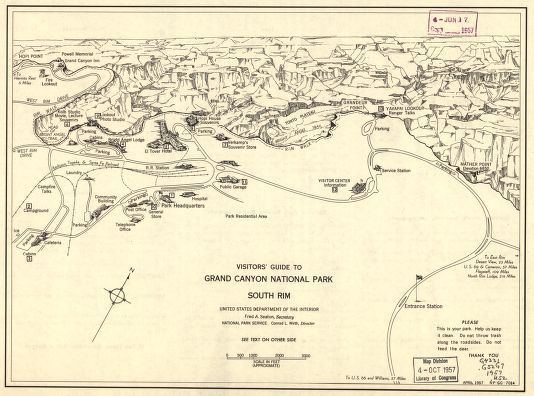Situated in the heart of the Grand Canyon South Rim historic district between the Bright Angel Lodge and El Tovar Hotel, the Thunderbird Lodge is an easily overlooked building. Yet the lodge is also one of the most heavily used sites at the Grand Canyon as a main staple in visitor lodging options. Built in 1968, this structure provides a portal into the more recent history of the Grand Canyon’s cultural landscape and environmental context.
In the early days of Grand Canyon National Park, many of the lodging structures along the South Rim of the Grand Canyon were built by the Santa Fe Railroad or by miners who realized that catering to park visitors paid out more than most mining activities in the area. This business scheme changed after Grand Canyon became a national park in 1919. The recently created National Park Service (initiated in 1916) stepped in at that point to manage and regulate the tourism at the Grand Canyon. Over the years the National Park Service and established Grand Canyon businesses developed a cooperative agreement which allowed for these businesses to operate tourist facilities such as lodging and eating service that were regulated by the National Park Service.
Over the years, Grand Canyon National Park continued to grow as a popular destination. Following World War II, a surge in tourism took its toll on park structures throughout the National Park System. In 1956, the National Park Service launched Mission 66; a ten year plan to refurbish and enlarge visitor services and infrastructure throughout the NPS units across the United States. The core of the plan was aimed at expanding interpretive and management facilities operated by the National Park Service throughout the United States, yet it also drove the management and planning that accounts for many of the hotels, restaurants, and other visitor services that are used today throughout the National Park System. At Grand Canyon National Park, Thunderbird Lodge is a good example of Mission 66-inspired architecture built by park concessionaires at the Grand Canyon.
Mission 66 plans at Grand Canyon National Park focused on enhancing and expanding visitor facilities while also dispersing new structures away from the canyon’s rim to alleviate crowding and overuse. At the Grand Canyon, however the national scope of the Mission 66 plans faced local challenges that were specific to the canyon’s cultural and environmental context.

This map of the Grand Canyon Village development from the late 1950’s shows the major buildings and roads along the south rim of the canyon. Note the location of the Thunderbird Lodge soon to be built between the El Tovar Hotel and the Bright Angel Hotel, shown left center of the image.
Photo: Library of Congress
Early in the 20th century, development along the south rim of this high desert park had already exceeded its limited supply of water and relied on regionally harvested water shipments to keep up with demand. To alleviate this issue, an extensive cross canyon pipeline was completed in 1970 that carried up water from Roaring Springs on the North Rim across the canyon to the South Rim. This new water supply provided enough water to support new development along the south rim of the canyon. Today’s South Rim Village inherited this development scheme inspired by Mission 66. The Kachina and Thunderbird Lodges sit near to the rim of the canyon, while many of the other lodges, restaurants, shops, and the grocery store are sited in the ponderosa pines just beyond the canyon rim.
On your next visit to Grand Canyon National Park, to walk past the Thunderbird Lodge and when you order that drink of water at the restaurant, think about the distance that water traveled to get into your glass.
Written By Yolonda Youngs
References:
- Carr, E. 2007. Mission 66: Modernism and the national park dilemma: University of Massachusetts Press.
- National Park Service. 2004. Grand Canyon Village National Historic Landmark District Cultural Landscape Report. United States Department of the Interior, National Park Service.

